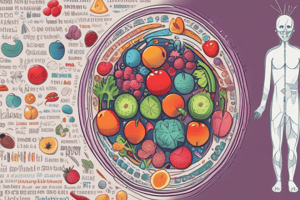Podcast
Questions and Answers
What characterizes disaccharides in terms of molecular structure and blood sugar impact?
What characterizes disaccharides in terms of molecular structure and blood sugar impact?
- They have simpler molecular structures and lead to rapid absorption rates.
- They have more complex molecular structures and lead to slower absorption rates. (correct)
- They have more complex molecular structures but lead to rapid absorption rates.
- They have simpler molecular structures but lead to slower absorption rates.
Which of the following is an example of a polysaccharide?
Which of the following is an example of a polysaccharide?
- Lactose
- Sucrose
- Amylose (correct)
- Fructose
What health risks are associated with consuming excessive simple carbs?
What health risks are associated with consuming excessive simple carbs?
- Decreased blood sugar levels
- Improved cholesterol metabolism
- Reduced risk of type 2 diabetes
- Increased risks of obesity and cardiovascular disease (correct)
How do complex carbs differ from simple carbs in terms of nutrient content and health benefits?
How do complex carbs differ from simple carbs in terms of nutrient content and health benefits?
What is the recommended proportion of daily calories that should come from carbohydrates according to the U.S. Department of Agriculture?
What is the recommended proportion of daily calories that should come from carbohydrates according to the U.S. Department of Agriculture?
Why does the USDA advise focusing on consuming nutrient-rich complex carbs while limiting simple carb intake?
Why does the USDA advise focusing on consuming nutrient-rich complex carbs while limiting simple carb intake?
What are the three main categories of carbohydrates based on their chemical structure and complexity?
What are the three main categories of carbohydrates based on their chemical structure and complexity?
Which of the following statements about monosaccharides is true?
Which of the following statements about monosaccharides is true?
What happens when two monosaccharide units combine?
What happens when two monosaccharide units combine?
Which of the following is a food source rich in monosaccharides?
Which of the following is a food source rich in monosaccharides?
What is the primary function of carbohydrates in the human body?
What is the primary function of carbohydrates in the human body?
Which of the following statements about the breakdown of carbohydrates is true?
Which of the following statements about the breakdown of carbohydrates is true?
Study Notes
Understanding Carbohydrates: Their Functions, Nutrition, and Health Implications
Carbohydrates, also known as saccharides or carbs, are a crucial component of human nutrition. As one of the three major macronutrients alongside proteins and fats, they serve a vital role in providing energy to the body. From sugars, starches, and dietary fiber, the human body breaks down carbohydrates into glucose, which is then converted into energy or stored for later use. The beneficial effects of carbohydrates extend beyond their immediate impact on energy production, influencing overall health, metabolic processes, and even disease prevention.
Classification of Carbohydrates
Carbohydrates are classified into three main categories based on their chemical structure and complexity: monosaccharides, disaccharides, and polysaccharides.
Monosaccharides
Monosaccharides, also known as simple sugars, are the simplest form of carbohydrates. They consist of a single sugar molecule with six carbon atoms, bound to hydrogen and oxygen atoms. Examples include glucose, galactose, and fructose. These simple sugars provide a quick burst of energy but may lead to rapid insulin release from the pancreas. Food sources rich in monosaccharides include fruits, honey, table sugar, and corn syrup.
Disaccharides
Disaccharides are formed when two monosaccharide units combine through glycosidic bonds with the elimination of water. Some common examples include sucrose (table sugar), lactose (found in milk), and maltose (formed during the digestion of starch). As compound sugars, disaccharides provide more complex molecular structures than do monosaccharides, leading to slower absorption rates and a less pronounced initial impact on blood sugar levels.
Polysaccharides
Polysaccharides, also referred to as complex carbohydrates, are made up of long chains of multiple monosaccharide units. These carbohydrate types take longer to break down, resulting in a gradual increase in blood sugar levels over time. Important polysaccharides include amylose (found in starchy foods like potatoes and rice) and cellulose (present in plant fibers).
Nutritional Considerations
Carbohydrates play several roles in human health. They act as primary fuel sources, help regulate blood glucose levels, participate in cholesterol metabolism, and contribute to overall nutrient intake. However, not all carbohydrates are created equal:
-
Simple carbs: Found in refined grains, added sugars, and some fruits, these readily digestible carbohydrates can cause rapid increases in blood sugar levels, potentially leading to weight gain if consumed excessively. Consequently, they've been associated with increased risks of obesity, type 2 diabetes, and cardiovascular disease when consumed in large quantities.
-
Complex carbs: Containing fiber, vitamins, minerals, and other essential micronutrients, complex carbs offer numerous health benefits beyond simple energy provision. Whole grains, legumes, vegetables, and fruit sources exhibit reduced risk of chronic diseases due to their nutrient profile and slow absorption rate.
Dietary Guidelines
The U.S. Department of Agriculture recommends a healthy plate approach, where approximately one-quarter of your daily calories should come from carbohydrates. Specifically, between 45-65% of total calorie consumption should originate from carbohydrates. To maintain balanced nutrition, focus on consuming nutrient-rich complex carbs while limiting intake of simple carbs, especially those containing added sugars.
Studying That Suits You
Use AI to generate personalized quizzes and flashcards to suit your learning preferences.
Description
This quiz covers the functions, nutrition, and health implications of carbohydrates. Learn about the classification of carbohydrates into monosaccharides, disaccharides, and polysaccharides, as well as the nutritional considerations related to simple and complex carbs. Explore dietary guidelines for carbohydrate consumption as per the U.S. Department of Agriculture recommendations.




